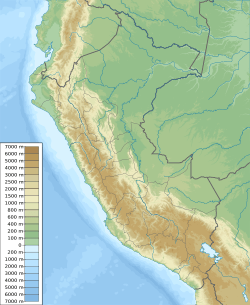Tambo Viejo facts for kids
|
Tambo Viejo
|
|

Tambo Viejo in 2022
|
|
| Coordinates | 15°26′55″S 74°36′59″W / 15.44861°S 74.61639°W |
|---|---|
| Type | Settlement |
Tambo Viejo is an archaeological site in southern Peru. It covers about 44 hectares (about 109 acres). This ancient place shows signs of people living there for a very long time.
You can find things from the Early Intermediate period, like old Nazca pottery. There are also buildings from the Inca period. Even remains from the Spanish colonial time have been found.
Contents
Where is Tambo Viejo?
The ancient site of Tambo Viejo is in southwestern Peru. It is about 20 kilometers (12 miles) from the sea. You can find it just south of the modern town of Acarí. This area is in the Caravelí province, Arequipa region.
A Look at Tambo Viejo's History
Tambo Viejo was one of several important centers built by the Incas. These centers were along the southern coast of Peru. Other places like Tambo Colorado and Paredones were also part of this network.
All these Inca centers were connected by the Inca trail. This trail was like a highway for the ancient Inca people. It helped them travel and manage their empire.
Early Discoveries
The first studies at Tambo Viejo happened in 1954. Dorothy Menzel and Francis A. Riddell explored the site. They noticed that Tambo Viejo was an Inca center protected by strong walls.
They also found very old pottery from the Early Nasca period. This showed that people lived there long before the Incas. Later, Lidio Valdez continued these important studies. His work helped us understand the site and the Acari Valley much better.
What Was Found at Tambo Viejo?
Tambo Viejo is built in a north-south direction. The main part on its north side is a huge rectangular area. This area is called Plaza Principal or Plaza 1.
A part of the Inca trail starts from its southwest corner. This trail leads to another site called Paredones. People think this was the main entrance to Tambo Viejo.
Inside the Site
The southern part of Tambo Viejo has many buildings. They are like a maze and connect to a smaller plaza. This central area is called Plaza 2. Around Plaza 2, there are rectangular buildings of different sizes.
South of Plaza 2, there is a large, tall platform. It seems to be man-made and stands over the whole site. On top of this platform, there are remains of wooden columns. These columns might have held up a roof.
North of Plaza 2, there is another smaller platform. East of the plaza, some buildings seem to be on a mound. All these structures suggest that Plaza 2 was a hidden and private place. You couldn't see it from the Inca trail.
How Buildings Were Made
The walls of the buildings at Tambo Viejo were built with two rows of stones. These stones were held together with a special mix called mortar. The outside of the walls was covered smoothly. Then, rectangular adobe bricks were added. Many of these bricks have fallen over time.
The buildings at Tambo Viejo do not have trapezoid-shaped windows or doors. This is different from typical Inca buildings. It might mean that the builders were local people. They might not have known all the Inca building styles.
Amazing Discoveries
During recent digs, some incredible things were found. Four naturally preserved llamas were discovered. Another llama was found in a state of decay. They were under the ground in one corner of the main plaza.
These llamas still had their decorations! They wore earrings, bracelets, and necklaces. These were put on them for a special ceremony. About one hundred guinea pigs (called cuyes) were also found. Their graves were marked with colorful feathers from tropical birds.
The guinea pigs were found in two different spots. They had decorations similar to the llamas. Some were even wrapped in carpets before they were buried. The remains of a dog were also found buried facing east.
Near Plaza 2, archaeologists found items for a game called pichqa. This word means "five" in Quechua. The game uses a die with different marks on five sides. Clay ovens were also found. These ovens seem to have been used to cook meals for special events. This shows how people socialized in Inca administrative centers like Tambo Viejo.
Gallery
See also
 In Spanish: Tambo Viejo para niños
In Spanish: Tambo Viejo para niños
- Acarí District
- Nazca culture
- Inca empire





